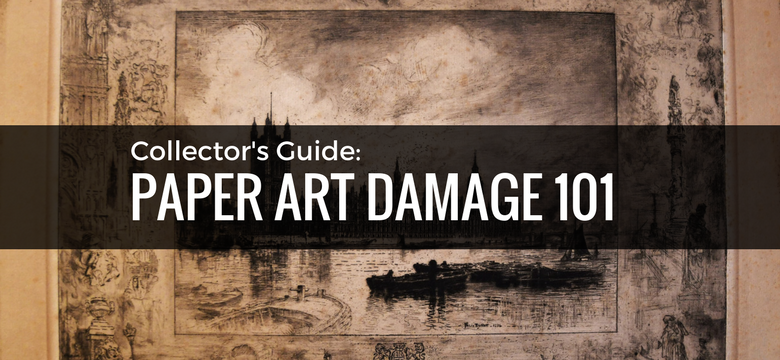
Mat burn, foxing, UV exposure, grime- all of these are incredibly harmful to your art work on paper but they are also rather ambiguous terms sometimes. What exactly is mat burn, how do I protect my piece against it?
Buy, Value or Appraise Your Fine Art – Paintings, Drawings, Sculptures
Bid or buy art for sale, value your item, or request a free appraisal to sell your collection.
Sometime last year, I brought home a beautiful Felix Buhot that hosts every hallmark of bad preservation that can be found in a work on paper outside of water damage– and when I say every hallmark, I mean someone did everything but dunk it in dirty water and pour red wine on this poor etching. The piece is Westminster Palace by Felix Buhot and is considered to be the artist’s greatest masterpiece. It is a gorgeous etching of Westminster Palace with famous scenes of London and its history etched around the edges.
Unfortunately, this means that a beautiful etching of some of London’s most iconic sites is in horrible disrepair. Fortunately, it gives me – an aspiring paper conservator – a practice subject for conservation and repair. In this condition, the piece is monetarily worthless, but if accurately repaired, can bring a fair amount at auction. Before we get to far, I should explain that I am an avid lover of history, art and a paper fanatic so I am using the utmost caution before taking any steps at cleaning this etching. However, while I am working on this, I thought I would share what all of these hallmarks of bad storage and framing look like, and how to prevent them from happening.
There are 5 major categories for paper art damage that happen naturally to paper if not stored properly (for example: creases and water damage require accidents or mishandling to occur).
1. Foxing
Foxing is almost unavoidable and happens to paper with age. Foxing is reddish brown spots that are caused by iron in the paper or mildew spores indigenous to the paper. The mold feeds on the paper as well as other organic materials that may happen to be on the paper like finger residue or food stains. Preventing foxing is difficult because it is often caused by content indigenous to the paper itself but the best guard is to keep your paper in a cool, dry, and clean environment, away from direct light.
2. Acidic burn
Wood is chock full of acid and is often the culprit behind the browning of paper. You can see here that the mat burn on this Buhot is somewhat severe. Whoever framed this piece, made two big mistakes:
- They used a mat created with wood pulp, and thus acidic, and also
- Closed the back of the frame with a piece of MDF board and did not add any kind of border between the board and the paper piece.
I strongly suspect that this MDF board was not ‘sized’, (sealed with some type of primer to protect the paper from the acidic wood), and thus adding to the discoloration. The mat burn you can really identify at the corners of the piece where there are extra dark lines that would have been scores on the back of the mat leftover from the framer cutting the mat to fit the piece. The dark border you can see in the image here is mat burn as is the discoloration below that dark line.
Another type of acidic burn can come from tape. The framer in this case used an acidic pressure sensitive tape (e.g. scotch or masking tape) to mount the piece to the mat. Not only did the framer use masking tape to mount the piece, he/she put 2-inch pieces all the way around the piece instead of just hinging it at the bottom.
Proper framing and conservation requires one strip that runs along the bottom of the piece, ‘hinging’ it to the mat to keep it in place. Taping it all the way around creates a potential for multiple discoloration marks like you see in this piece and it can cause stress on the paper – it’s also impossible to remove without damaging your piece. If you are hinging a piece, choose your non-acidic adhesive wisely, I would suggest using something that has a water-soluble adhesive. There are many fabulous alternatives to adhesive mounting though, so if your piece holds sentimental or monetary value, always speak to a conservator or competent framer before doing anything potentially damaging like using the wrong materials and methods in framing. The Minnesota Historical Society has an incredible instructional article on the proper way to frame paper art titled: “Advice for Framing Art, Documents, Letters, Photographs and Other Paper Items“.
3. UV damage
Paper in all forms is extremely sensitive to light, low quality papers like newsprint are even more susceptible to light damage than heavier papers. Not only does prolonged exposure to light discolor paper, it also irreversibly changes the chemical composition and makes paper brittle.
Take a look at my etching, for example:
Buhot used a very nice, thick paper and it is not brittle at all, in fact, the paper fiber is in excellent condition. The problem is that the paper has turned a yellowish color. That could in part, be from the MDF board the framer used for backing, but judging from the Plexiglas used on the frame, I would guess this piece was exposed to a fair amount of light and grime. The glass is very unclear and the fog over it is a yellowish color, which indicates something like cigarette or cigar smoke and light discoloration. The piece does not smell like smoke so light damage is more likely. The dark yellow-brown around the edges of the etching are from the mat burn discussed earlier but the lighter yellowish color on the main part of the etching would be largely from acid and light damage.
I have hopes that it is reversible because the quality of the paper is not diminished, but Felix Buhot mostly used a white or light ivory paper so I know there is a clearer color under all of the mucky yellow. Keeping your painting crisp and clear of light damage takes care but is not hard. Direct sunlight is the most damaging type of light but infrared light and ultraviolet light are what damage the construct of the paper itself. Some spotlights or room lights put off UV and Infrared rays that can damage your paper piece.
To properly maintain the integrity of your paper work, make sure that your piece is in a room with no exposure to UV or Infrared rays, and look for unlikely culprits like lightbulbs or spotlights. For more information on light damage, check out the National Gallery of Art’s article on the Effects of Light Exposure. Another way to protect your piece is to frame it behind Museum Glass, which filters harmful rays. Talk to your local framer about it if you would like to go that route. The Framer’s Workshop in California is very good at explaining how Museum Glass helps block harmful rays
4. Grime
Grime or ‘schmutz’ as my painting instructor liked to call it, is the unexpected culprit. The previous four issues for paper can be controlled by changing the environment around your paper work. Schmutz is a harder problem to manage. Grime is literally in the air and everywhere! Finger prints, dust, smoke, particles from your breath even, qualify as grime that can potentially settle on your paper work and muddy any colors and dirty the paper. Framing your paper work behind glass is helpful but even then, dust can get into the frame unless it is sealed professionally, which can be very expensive.
The best thing you can do to minimize grime on your paper work is to brush it off occasionally with a very fine, soft brush. Be sure you have an extremely soft brush because bristles can leave abrasions in your paper. If you decide to brush off your paperwork, make sure you have it on a flat, slanted surface and brush down very gently so that any dust will roll to the bottom of your slanted surface. You may never see much dust or grime but trust me, it is there.
For other types of cleaning and preservation, the Northeast Document Conservation Center has some nice tips, but as a rule, always contact a conservator to clean your paper works. Paper and its chemistry are very delicate in nature and easy to disrupt if handled improperly so caution is always advised.
So what to do with my pretty little Felix Buhot? I am taking my own advice and consulting with a conservator about how to proceed. There are some tricky elements, like the graphite signature that would come off in a conservation bath, so I will be stepping very carefully in this venture. Until I feel confident toward my next step in restoring this etching to its former glory, it is stored in a flat, dry area and in no contact with wood or woodpulp. Someday, it will be restored to its former glory!
Wanna see more art? Visit our fine art department to view upcoming auctions and to browse our auction archives.
Written by: Kathryn Hoogendoorn







Kathryn,
I own an 1844 James E DeKay New York Fauna Book Vol II: Birds. It has all the damage sited in your article and more so. I have all the Bird plates but many are detached from the spine. His pictures were water-colored and are very detailed and beautiful.
What would a it take me to have this book appraised and restored? Can I send you photographs?
Hello,
Thank you for your message. Please email images and these details to our Rare Book Specialist, Mr. James Gannon at JamesG@HA.com. He can assist you.
I have two pieces of illustration art which were exposed to sunlight. You mention that light damage may be reversed. How can that be done?
Hello,
Thank you for your message. Please email images and these details to our Rare Book Specialist, Mr. James Gannon at JamesG@HA.com. He can assist you.